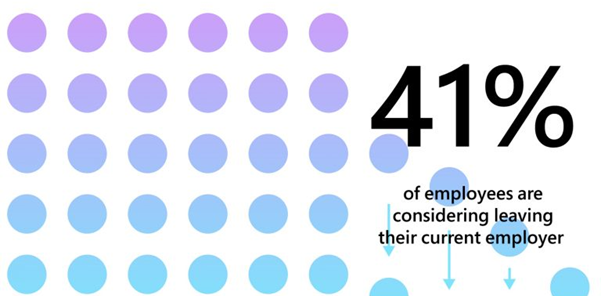
The last few years have seen organisations shift to hybrid and remote working models – in many cases, with some urgency. Many companies rushed to adopt and deploy new technologies in reaction to the changes in ways of working we’ve seen across the world.
But having hurriedly invested in these technologies, many organisations may now be experiencing a form of technical debt, with the impacts felt keenly by those whom the technology was deployed in the first place: employees. So how can employers stop technical debt in its tracks and get the most from the investment?
What is technical debt?
Generally speaking, technical debt can be described as the consequences of technology decisions that prioritise quick deployment and short-term benefits over long-term value to the business.
When we relate this to the quick adoption of remote working technologies, we can see many examples of businesses who may have deployed software and hardware to make hybrid working possible for their workers in the short term. In some case this will accelerate long-term plans, but many others will have been reacting to necessity during the pandemic. Now many employees are left using tech that doesn’t suit their working needs or contribute positively to their employee experience.
What is employee experience?
To fully understand how employee experience and technical debt are interlinked, it’s important to know what employee experience it is and how it can be affected by the technologies people use in their day-to-day work.
Employee experience (EX) refers to the experiences workers have within their company compared to their expectations. Good employee experience leads to staff feeling more connected and engaged with their work – they will be more productive and have better working relationships with their colleagues and leaders.
On the other hand, poor employee experience will cause staff to feel disconnected from their work, which can lead to a deterioration of their personal wellbeing. Job motivation will also decline with poor employee experience, and with this, so will the quality of work. Ultimately, when employees feel dissatisfied, they will look for other opportunities. You risk losing valuable staff.
Although it may sound similar, it’s important to note that employee engagement differs to employee experience. Employee engagement is concerned with workers’ ability to effectively carry out their work and how motivated, empowered, and energised they feel at work. Employee engagement is an important factor to consider when it comes to the technologies we use, but it doesn’t equate to the whole of employee experience.
Employee experience: the facts and the figures
Today’s workforce values employee experience more now than ever before. According to the Microsoft 2021 Work Trend Index:
- 54% of global workers feel overworked and 39% feel exhausted
- 60% of Gen Z workers (aged 18 to 25) say they are struggling or merely surviving at work
- 17% of workers have cried with a co-worker
- 41% of the global workforce is considering leaving their job due to burnout or lack of workplace flexibility

We’re at a crossroads where employees are being more open about their workplace happiness than ever – they’re more likely to make changes to their employment based on this – and employers need to make changes to reflect this, or risk losing talent.
What do employees really want?
Microsoft also found that, globally, leaders are out of touch with their employees and need a wake-up call. Compared to 61% of leaders who say they are currently thriving, only 38% of those in non-leadership positions are feeling the same way. So, what is it that employees want that their leaders don’t understand?
A recent study by McKinsey and Company looked at the disparity between what is valued by employers and their employees. The study found that employees found relational factors more important, while their employers tended to prioritise transactional factors.
The following factors were valued by employees but seen as less important to their employers:
- Being valued by their organisation
- Being valued by managers
- A sense of belonging at work
- The potential for career advancement
- Having caring and trusting teammates
- Having a flexible work schedule
On the other hand, these factors were seen to be less important to employees than their employers believed:
- Looking for a better job
- Receiving inadequate compensation
- Poor health
- Opportunities for development
- Being poached by another company
- The ability to work remotely
There is a clear disconnect between what global workforces want from their jobs, and what their employers think they want – and leaders need to spend more time connecting with staff to understand their needs, especially in remote working situations where there is less opportunity for in-person interactions.
Technology and the employee experience
Workers’ environments and the tools they have access to are contributing factors to their employee experience. Technology plays a core role in most workplaces today, and many employees are reliant on the tech they use to carry out their work. If this technology doesn’t empower employees to complete their workloads in an effective and efficient manner, it will lead to a negative employee experience.
As we’ve moved to remote and hybrid working models, it’s also become clear just how much technology affects the working environment – not just in terms of the physical hardware. With teams divided between the office and homeworking, the technology we use has become our working environment. The digital workplace is now more important than ever. Employees are using technology as a space to meet with colleagues, collaborate on projects and complete their workloads. To positively affect EX, a digital workplace should offer (as best as it can) the same benefits for all employees no matter where they are working from.
There is a clear impact of technical debt on both employee experience and the wider business. Hastily adopting technologies with a limited view of how they will be used in the long term affects the business at all levels. At a high level, IT leaders will have to spend time reassessing the technology frameworks within the business. And, of course, there can be financial implications involved with adopting further systems within the business that complement the company’s long-term values.
At the employee level, new technology that doesn’t meet their working needs will obviously have a negative effect on EX. Adopting another new set of technologies to combat technical debt will also take a toll on employee experience. Implementing new tech in the workplace isn’t as simple as just adoption and deployment. Your people will need training and time to fully understand new systems. But it’s also important that they understand the reasons why this new technology is being adopted.
For IT leaders scoping out new technologies, getting it right the first time will ensure that the tech you adopt helps the business to achieve its goals, and will also create an environment for a positive employee experience.
How can your business get it right the first time?
Adopting new technologies shouldn’t be an overnight decision. Careful thought and planning should go into your business’ strategy to make sure the tech works for you and your people.
Business change and adoption
Putting business change at the heart of employee experience initiatives will ensure you are addressing business needs, rather than ticking a technical box. A subject matter expert (SME) in business change will assess the current state of employee ways of working and engagement before recommending and planning for what and how to change.
When a business utilises the skills of a business change SME, they take into consideration their long-term goals, values, and needs of the company and its employees at all levels. They will look at how new technologies might positively or negatively impact each area across the business but more importantly ensure it is implemented in a meaningful, valuable way. Organisations can avoid the technical debt associated with implementing technologies that don’t serve the business in the long run and can also foster a culture for good employee experience by choosing technologies that do.
User research
A typical factor in the failure of digital transformation projects is a lack of time spent getting to understand the needs and culture of those who’ll ultimately be using the new services. Indeed, at Content+Cloud, we stand by the belief that successful business change is 20% about the technology, 80% about people.Working with a partner that specialises in user research will help ensure that your people are placed at the heart of technological change. Steps such as undertaking employee interviews and creating user personas will give you a better idea of the types of roles, scenarios and user journeys you need to consider as part of your action plan. This insight will go on to shape your engagement model with your employees, ensuring all change is contextual and considered.
Digital maturity models
Digital maturity refers to a business’ ability to react and adapt to new trends in technology. A digital maturity model (DMM) is a framework which is used to assess and improve this. While digital maturity is something that business can strive for, it isn’t a one-time achievement. As the digital landscape is constantly evolving, businesses need to adapt and keep an evergreen mindset to keep up.
Digital maturity models are usually focused on data-driven insights. Understanding where your business is now and where it needs to be are key for defining a DMM. With this in mind, leaders can build a roadmap for their future strategy. This enables organisations to take the time to consider how new technologies will affect the business over time. Data and insights on employee needs and values can also help businesses to understand how new technologies will contribute to the employee experience.
Microsoft tools for improving the employee experience
Microsoft 365 is built for the hybrid working world and offers workers a customisable experience wherever they are based. As a Microsoft Gold Partner, Content+Cloud we can help you get the most from Microsoft’s technologies for the modern workplace, whether you’re looking to deploy for the first time, need support with managing your services or want to better understand how the solutions have been adopted.
Here are some of Microsoft’s top tools for improving employee experience.
Microsoft Teams
You may be familiar with the group chat and meeting software of Teams – but it’s so much more than that. Teams works as a digital workplace where employees can connect with each other, collaborate on projects, and access all of the files and information they need, whether remote or in the same room. Teams is also a perfect solution for those organisations looking for cloud calling capabilities.
Microsoft Viva
Viva is Microsoft’s dedicated employee experience platform (EXP) and is integrated into Teams and SharePoint. If you have a SharePoint-based intranet such as Fresh, this gives employees a fully connected digital workplace. The Viva portfolio experience is split into four apps:
- Viva Insights: Balance productivity and wellbeing with data-driven insights.
- Viva Topics: Connect to knowledge and experts.
- Viva Learning: Make learning a natural part of your day.
- Viva Connections: Stay engaged and informed.
Yammer
Yammer is Microsoft’s enterprise-based social media tool that allows leaders to keep their people up to date on important matters and enables colleagues to stay connected with one another.
Meet the Experts: join the discussion on employee experience and technical debt
If your business has employee experience on the agenda and is looking to adopt new technologies, join James Lewis, Head of Sales Expertise, and Daniel Hipkin, Solution Expert, as they discuss technical debt in our on-demand webinar.


